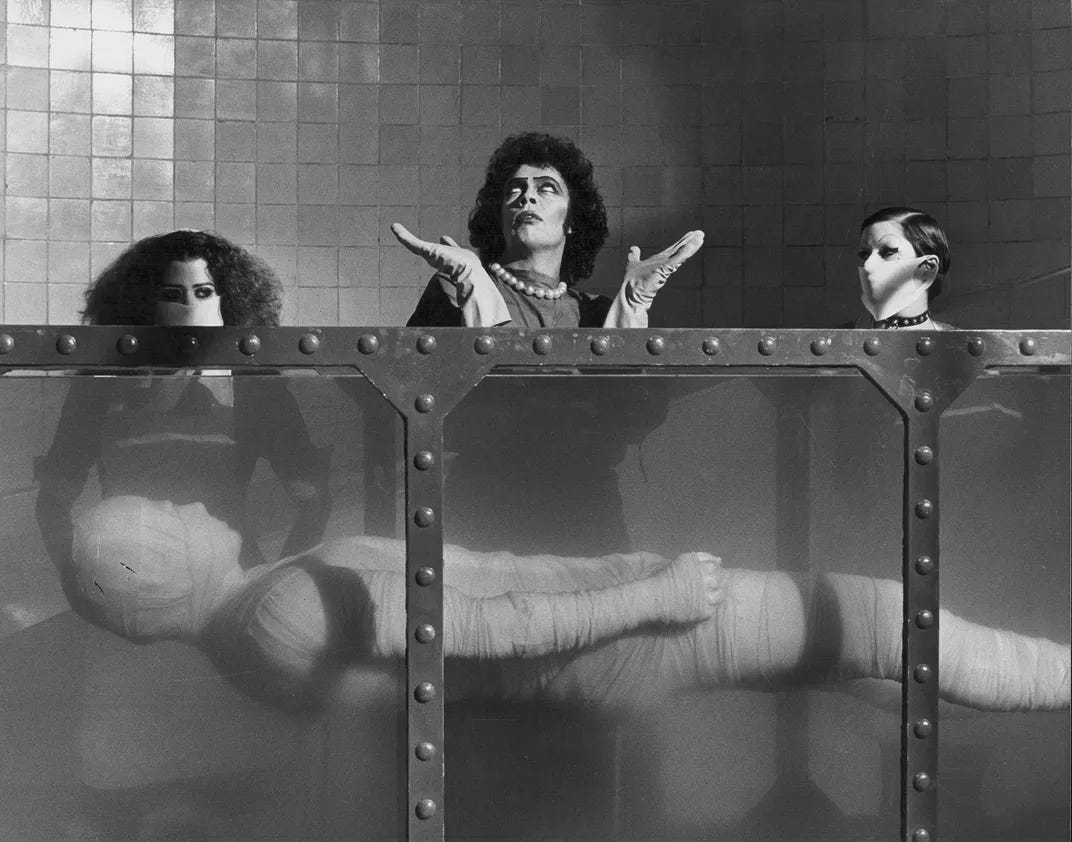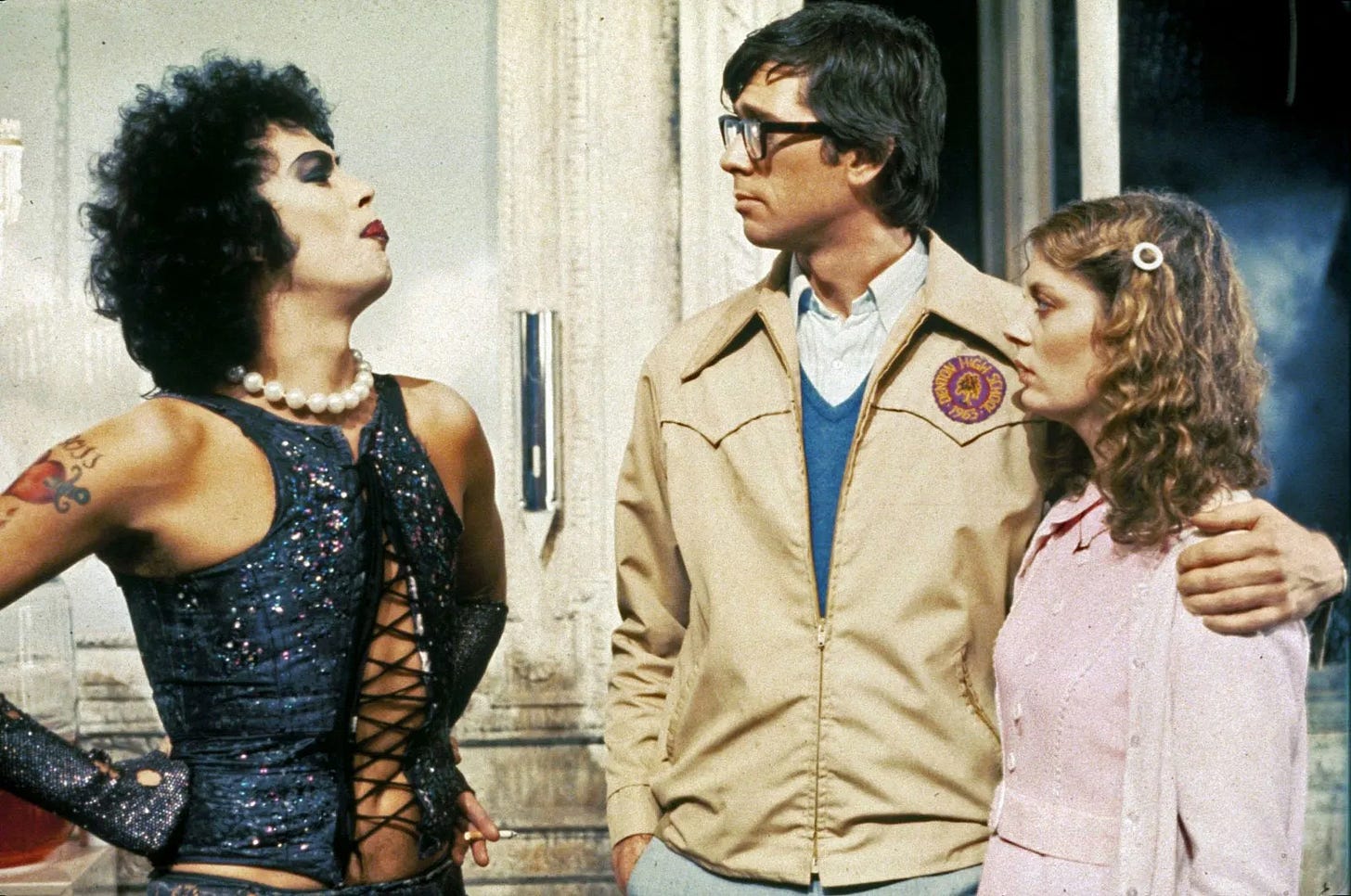Why Are Gays So Obsessed With ‘Rocky Horror’?
The Lasting Impact of Camp on The Queer Community
2025 marks the 50th anniversary of “The Rocky Horror Picture Show,” a film that has cemented its place in queer history and culture as the epitome of what it means to be “camp.” However, upon initial release, the film was a complete flop. Audiences didn’t understand it, critics hated it, and the film’s theatrical run was cut woefully short.
This failure presents a question: How did this movie become so popular? When the inferno of “Rocky Horror’s” widespread hostile reception died down, small groups of people, living on the outskirts of acceptable society, found themselves searching for midnight showings of the film. Having these showings take place at midnight took full advantage of the overt raunchiness of the movie. Midnight movies are a tradition that has been bringing together those on the edges of society since the mid-20th century. Films shown late in the night were quirky and countercultural, as cinemas and television channels neglected to give prime screen time to bizarre flicks. These showings created a haven for the marginalized groups who wanted to see movies that better represented their camp entertainment preferences.
In years following, the practice of the shadow cast—a batch of thespians performing scenes from the film in a lip-sync-esque fashion in front of the actual movie—became a nationwide Halloween tradition.
What is Camp?

To provide an adequate definition of camp, we must visit Susan Sontag’s 1964 essay, “Notes on Camp.” Sontag is largely responsible for the widespread use of the word “camp” by scholars and the general population alike. Sontag explains, camp garners such a variety of reactions because it is unashamed of prioritizing style over content. Many movies classified as camp are so infamous because they make no sense; they take place in a reality where offbeat humor and bizarre aesthetics take precedence over plot.
“Camp is a vision of the world in terms of style—but a particular kind of style,” she wrote. “It is the love of the exaggerated, the ‘off,’ of things-being-what-they-are-not.”
Camp also ignores the mode of criticality through which many people view media. It focuses on emotion over judgment, creating an overarching “vibe” as opposed to a rigidly constructed story. Sontag notes this hard-to-understand aspect of camp as a “badge of identity” among small communities. As the idea of camp has evolved, particularly in cinema, it has become inextricably tied to queer communities. The most absurdist of media can be best understood by people who are viewed as unconventional.
Queer Audiences and Camp
One of the most iconic campy films of all time is “Pink Flamingos” by John Waters: an unashamedly disgusting movie that has become a cult classic in LGBTQ+ film circles. Waters is a deliberately provocative director whose films never tried to appeal to a broad audience, so unlike “Rocky Horror” director Jim Sharman, Waters knew his movies were never going to succeed in the traditional sense. He knew his audience was the outcasts from the start, so he cast the notoriously gross drag queen Divine as the leading lady.
“Pink Flamingos holds a vital and influential space in LGBTQ culture, politics, and identity. It is uninhibited, unabashed, unapologetic, and undeniably individual,” Tony Sokol wrote in his article on the matter.
This film came out just three years before “Rocky Horror,” and both proceeded to become central to the “midnight movie” phenomenon.
Transylvania as Camp Heaven

Dr. Frank-N-Furter (Tim Curry) is a “sweet transvestite from Transsexual Transylvania” along with his other dazzling housemates. What exactly is Transsexual Transylvania? It is not explained because that’s not the point. All that matters is the over-the-top camp aesthetic of each of its prior inhabitants.
One of Frank-N-Furter’s most spectacular groupies is Columbia (Nell Campbell). Like the rest of the alien cast, she is infatuated with the androgynously-sexy doctor, but her outfits and humor are particularly standout. She enters the film wearing a fully bedazzled suit and singing in a high-pitched, cartoonish voice to begin the “Time Warp” number. This places her at the center of the Transylvanian community, a place for the world’s most oddball misfits, a place that much of the audience yearns to find.
Much of the LGBTQ+ community can also resonate with the journey of Brad Majors (Barry Bostwick) and Janet Weiss (Susan Sarandon), who arrive at Frank-N-Furter’s lair after singing an anthem of heteronormativity, “Dammit Janet,” and then seeing “a light” in the comically spooky castle. In her paper, “The Rocky Horror Picture Show’s Impact on Queer Communities,” Jackie Roach explores the many reasons this film had a lasting impact on queer audiences; one of which being the castle as a center for sexual liberation. Brad and Janet’s journey is a sort of coming-out story (one much more fantastical than most; we all wish we could’ve discovered our sexualities through glammed-up Tim Curry).
“The two spend the night in the castle coming to terms with their own sexual desires and learning to brazenly celebrate their sensuality,” Roach wrote. “However, the film ends with Brad and Janet in the ashes of where the castle once was, a parallel to the uprooting of many queer communities by police raids.”
The Star of The Show
Arguably, Dr. Frank-N-Furter is the most iconic villain in horror history. Writer Richard O’Brien took the mad scientist archetype popularized by the 1931 “Frankenstein” and combined it with a much less common persona: flamboyant, sexual, and openly queer.
Mainstream audiences were not prepared to see Curry in drag, oozing sexuality. “Rocky Horror” began as a Broadway musical, and even theatre goers were aghast by the Doctor’s outright offensiveness. Still, Frank-N-Furter stuck with audiences, especially those who saw a trapped part of themselves in his androgynous presentation. For many LGBTQ+ viewers, he was their introduction to seeing pure queer joy (with a touch of villainy) on screen.
Curry’s performance transcended traditional gender and sexual boundaries because he didn’t approach the drag queen-inspired character as someone in drag; he approached the Doctor as a unique individual. In a 2005 NPR interview, Curry summed up this acting approach.
“Never think about it as drag because it’s not,” he said. “It’s just what people wear in Transylvania, just get over it.”
The Doctor holds significant importance in queer culture beyond just being a popular Halloween costume. He is a mischievous villain who shows little consideration for those around him, but queer audiences did not see him as evil; they saw him as the holder of a unique, colorful space, contrasted with the frightening, dull outside world. He is a mad scientist who sports a pink triangle and bedazzled gloves, erotically singing all the way.
The allure of “The Rocky Horror Picture Show” lies in its ability to create something incomprehensible but aesthetically extraordinary. By unashamedly reveling in the absurd, it has inspired audiences old and new to embrace the madness of camp as a way to express their true selves.
“Give yourself over to absolute pleasure/Swim the warm waters of sins of the flesh/Erotic nightmares beyond any measure/And sensual daydreams to treasure forever/Can’t you just see it?/Don’t dream it, be it” (“Rose Tint My World” from “The Rocky Horror Picture Show”).
Edited by Lilli Eve




I just rewatched it at the theater for the first time in a while. Here's my review on Letterboxd for anyone who is interested:
Wow, it's been fifty years since the mother of all cult movies started its run in 1975 on the midnight movie circuit. During that time, I've seen it in packed theaters where rice, toast, and water are flying through the air on cue, and audience members dance and yell at the screen in unison. "You sure know how to pick your friends", "bloody rubbers", and of course, "asshole!", referring to Brad Majors, to name a few. I've also watched it on Blu-ray often during this spooky time of year.
But tonight, I watched it with maybe twenty other people in a theater, with no dancing, yelling, or flying objects. Instead, I quietly immersed myself in this sexy spoof of twentieth-century monster and sci-fi films. With a beautiful, glammed-out cast that is captured in vividly saturated color, a deliciously decadent script, and devilishly clever rockers and ballads, it still has a strange, mesmerizing pull all these decades later.